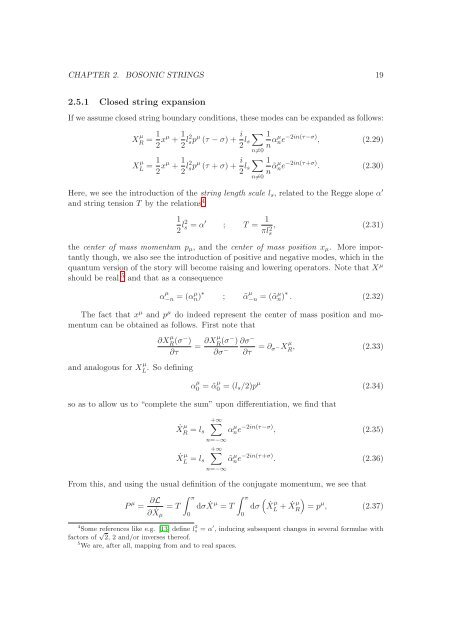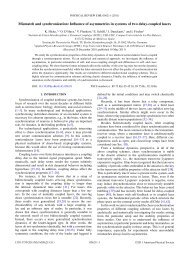DBI Analysis of Open String Bound States on Non-compact D-branes
DBI Analysis of Open String Bound States on Non-compact D-branes
DBI Analysis of Open String Bound States on Non-compact D-branes
Create successful ePaper yourself
Turn your PDF publications into a flip-book with our unique Google optimized e-Paper software.
CHAPTER 2. BOSONIC STRINGS 192.5.1 Closed string expansi<strong>on</strong>If we assume closed string boundary c<strong>on</strong>diti<strong>on</strong>s, these modes can be expanded as follows:X µ R = 1 2 xµ + 1 2 l2 sp µ (τ − σ) + i 2 l ∑ 1sn αµ ne −2in(τ−σ) , (2.29)n≠0X µ L = 1 2 xµ + 1 2 l2 sp µ (τ + σ) + i 2 l ∑ 1sn ˜αµ ne −2in(τ+σ) . (2.30)Here, we see the introducti<strong>on</strong> <str<strong>on</strong>g>of</str<strong>on</strong>g> the string length scale l s , related to the Regge slope α ′and string tensi<strong>on</strong> T by the relati<strong>on</strong>s 4n≠012 l2 s = α ′ ; T = 1πls2 , (2.31)the center <str<strong>on</strong>g>of</str<strong>on</strong>g> mass momentum p µ , and the center <str<strong>on</strong>g>of</str<strong>on</strong>g> mass positi<strong>on</strong> x µ . More importantlythough, we also see the introducti<strong>on</strong> <str<strong>on</strong>g>of</str<strong>on</strong>g> positive and negative modes, which in thequantum versi<strong>on</strong> <str<strong>on</strong>g>of</str<strong>on</strong>g> the story will become raising and lowering operators. Note that X µshould be real, 5 and that as a c<strong>on</strong>sequenceα µ −n = (αµ n) ∗ ; ˜α µ −n = (˜αµ n) ∗ . (2.32)The fact that x µ and p µ do indeed represent the center <str<strong>on</strong>g>of</str<strong>on</strong>g> mass positi<strong>on</strong> and momentumcan be obtained as follows. First note that∂X µ R (σ− )∂τ= ∂Xµ R (σ− ) ∂σ −∂σ − ∂τ = ∂ σ −Xµ R , (2.33)and analogous for X µ L . So defining α µ 0 = ˜αµ 0 = (l s/2)p µ (2.34)so as to allow us to “complete the sum” up<strong>on</strong> differentiati<strong>on</strong>, we find thatẊ µ R = l sẊ µ L = l s+∞∑n=−∞+∞∑n=−∞α µ ne −2in(τ−σ) , (2.35)˜α µ ne −2in(τ+σ) . (2.36)From this, and using the usual definiti<strong>on</strong> <str<strong>on</strong>g>of</str<strong>on</strong>g> the c<strong>on</strong>jugate momentum, we see thatP µ = ∂L∂Ẋµ= T∫ π0dσẊµ = T∫ π0)dσ(ẊµL + Ẋµ R= p µ , (2.37)4 Some references like e.g. [13] define ls 2 = α ′ , inducing subsequent changes in several formulae withfactors <str<strong>on</strong>g>of</str<strong>on</strong>g> √ 2, 2 and/or inverses there<str<strong>on</strong>g>of</str<strong>on</strong>g>.5 We are, after all, mapping from and to real spaces.
















